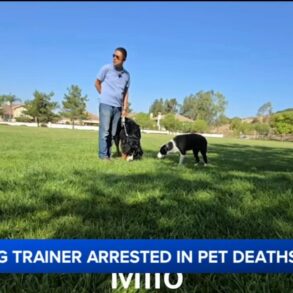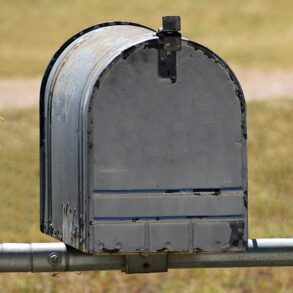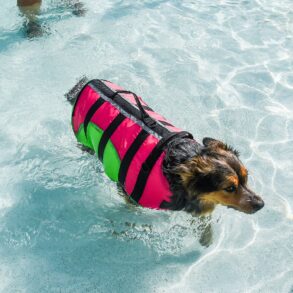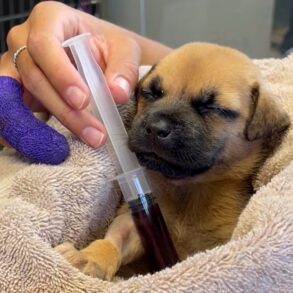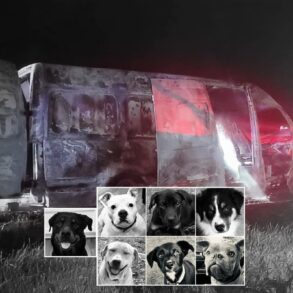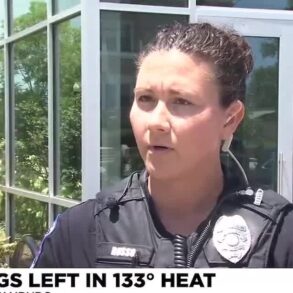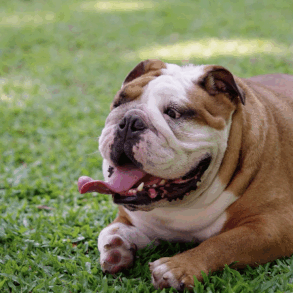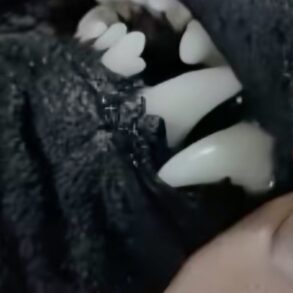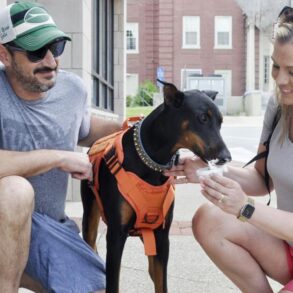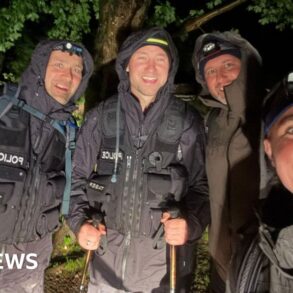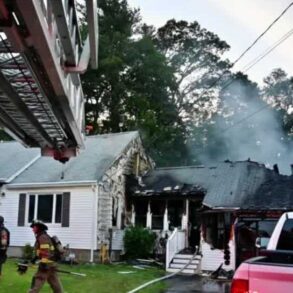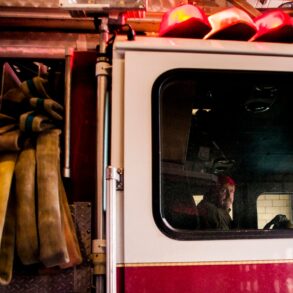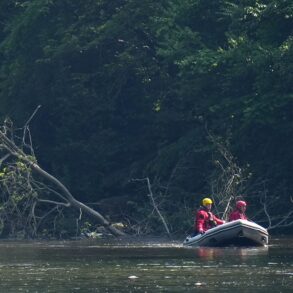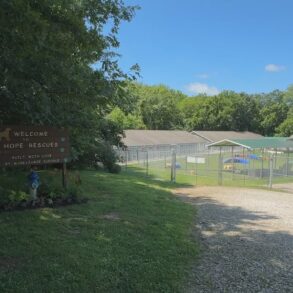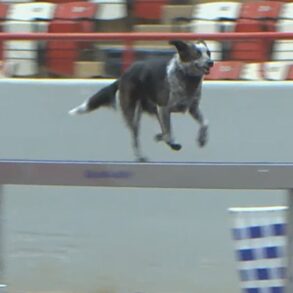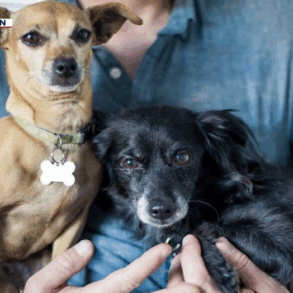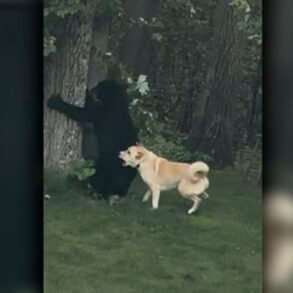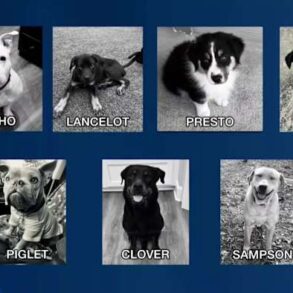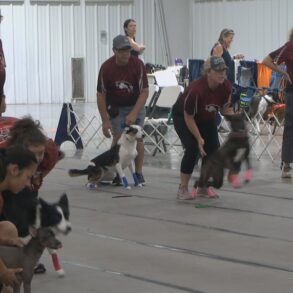By Jaymie Baxley
The remnants of Hurricane Helene claimed at least 101 lives in western North Carolina, burying many victims beneath rubble and floodwater.
Highly trained dogs have played a crucial role in finding victims’ remains; one canine-assisted search team from Guilford County recovered 20 bodies in the immediate aftermath of the storm. These specialist canines and their handlers are likely to find more casualties in the weeks to come, according to cadaver dog expert Cat Warren.
A former journalist and English professor at N.C. State University, Warren became a cadaver dog handler after training her German shepherd, Solo, to detect the scent of human remains. She wrote about their experiences searching for the deceased in “What the Dog Knows,” a New York Times bestseller published in 2013 that explores the science and history of working dogs.
Warren recently spoke with NC Health News about the grim but essential service provided by cadaver dogs and the challenges they’ve faced after Helene. Her comments have been edited for length and clarity.
NC HEALTH NEWS: What are some of the unique challenges involved in training a dog to detect human remains — especially in disaster scenarios like hurricanes?
CAT WARREN: Disaster work adds bunches of challenges on top of just finding the scent of human remains.
It takes absolute experience for the dogs and handlers to work in these situations. Very often, they are working through mud or they’re on a boat going down very swollen rivers or lakes. They have to be physically fit and enormously resilient.
In a tragedy like this, you also have so much competing odor. There’s decaying food, decaying livestock and garbage. It can be a challenge for a dog to work through those competing scents to locate the scent of human remains.
When a dog is in “scent mode,” it’s doing the equivalent of hyperventilating. Their sniff rates are going up, and it just takes more out of them, especially when they’re also having to negotiate all this impossible territory. The work is super tiring.
Many times, the dogs will work for hours and hours without finding anything. After they find something, they will rest briefly before being washed down to get rid of any environmental contamination they may have been exposed to. Then it’s back to work.
NCHN: How do factors like flooding, mudslides or dense forests affect the ability of dogs to detect remains after events like hurricanes?
WARREN: There are huge barriers in simply being able to get the dog to the places where the scent is available.
These are scent detection dogs, not body detection dogs. If somebody is buried under rubble or mud or is underwater, the dog is simply telling the handler that they smell the odor of human remains. In a disaster like this, the handlers have to know their dogs incredibly well.
You have this moment called a “change of behavior,” where the dog might lift his head or get a particular crank in his tail. Now, it’s conceivable that some of these dogs are trained to bark or sometimes sit down in ideal situations. I know it sounds weird that there are “ideal situations,” but if you’re searching for somebody who’s missing in the woods, it’s a whole lot easier for the dog to get to where that scent is and to get as close as possible to where the victim is.
But in these cases, the dog may not be able to get close enough or the scent is so fractured that the dog is somewhat uncertain. That’s when the handler is going to tell people who are flanking them, “Look, the dog showed real interest here.” The dog may not give his final indication because that body or that scent is underneath a pile of debris, so it’s then up to the searchers to go in and search that pile of debris.
NCHN: How would you describe a typical search operation involving cadaver dogs in disaster-hit areas? Is there a timeline for the work?
WARREN: It’s grim, but the timeline for this is going to be months because there’s such a huge area to search.
Officials are still gathering accounts of where people went missing, and we have a homeless population in Asheville that is probably very much still unaccounted for. Also, from the point of view of the dogs, scent becomes, let’s face it, more and more available to them the longer somebody goes missing.
If we think about these mudslides and the mud hardening, it sadly increases the likelihood that all of the victims won’t be recovered because these essentially become burials. But scent can very often find a way to the surface, which is why we’re using dogs right now on burial sites that go back hundreds of years.
Part of the challenge here, frankly, is that we’ve had people go in with dogs that are not properly trained. They want to be heroes and they want to get attention, so we’ll have these areas that have been “searched” but not with effectively trained teams. People are going to have to go back in and re-search those areas.
NCHN: Is there a system for distinguishing untrained dogs and handlers from those that have been properly trained?
WARREN: Yes and no. For people on the ground searching, it can be hard to distinguish handlers with dogs that have been deeply trained from well-meaning people or attention seekers who are a little bit delusional about what the conditions are and what their dogs are capable of doing.
Handlers for FEMA and the U.S. Army Reserves have high standards and requirements for training dogs, so those dogs tend to have more of what it takes. That said, there are also excellent dogs and teams not employed by those agencies who are familiar with mountain searching and mountain areas.
There are dogs and handlers who are very much up to doing this and doing it properly, but there aren’t thousands of them out there. It’s an enormously complicated, professional thing that these folks do. And when you think about what it takes — the money, the time and the skill — it amazes me that there are as many as there are.
NCHN: How do handlers familiarize their dogs with the scent of human remains?
WARREN: There are people who use something called pseudo scent, which is a compilation of the complex chemicals that make up the scent of human remains, but training with actual human remains is ideal.
Access to that kind of training material can differ from state to state, depending on the state’s regulations. Hospitals sometimes have agreements with FEMA teams allowing access to human material. When I was training with Solo, I had access to training materials that came from the medical examiner.
There are also facilities popularly known as body farms, although that’s a bit of a crude term. Western Carolina University hosts seminars for dogs that are training to detect human remains. During these seminars, dogs and handlers have access to old bodies or large sets of remains, which is enormously important for training.
Can a dog locate an entire body after only training with small amounts of bone or teeth? Absolutely. But you can imagine how overwhelming or even frightening it can be for a dog that hasn’t been absolutely exposed to the scent of remains to be hit in the face with a whole bunch of scent.
It’s not overwhelming because the dog is thinking, “Oh my God. This is a deceased human. I can’t handle this.” The dog is more likely thinking, “That’s a load of scent that I’ve never been exposed to, and I’m not sure what to do with it.”
NCHN: What improvements or advancements have you seen in cadaver dog training that could enhance future search and recovery efforts?
WARREN: Generally, training over the past 20 years or so has improved at the highest levels because people have a greater understanding of how positive reinforcement and motivation can be used to train dogs in a really disciplined way.
Some dogs are motivated by a toy reward, while some of them are motivated by the joy of the hunt and are self-rewarded, in a sense, by the hunt itself. If you think about border collies, they don’t get a toy at the end of herding sheep. They just love to herd sheep.
One of the things that handlers are doing all the time is figuring out how to keep these dogs motivated over long search periods. It takes a lot of talent and a lot of training to ensure that a dog who won’t be rewarded for a long time is still willing to work.
These dogs aren’t doing this because they want to give closure to loved ones. They’re doing it because they’re dogs and they really love doing this work. But the handler’s motivation is somewhat different. They are professionals, and they’re setting aside any emotion while they’re doing this work because they have to.
It truly is analogous to a surgeon walking into an operating room. The surgeon isn’t thinking about that person’s family and how they’re going to feel. The surgeon is thinking about doing the best work possible with their training in that particular situation.
For handlers, some of the feelings may come afterwards. These guys are doing really, really hard work. It is exhausting, and it takes a real physical and emotional toll. I’m hugely admiring of people who can do this.
This post was originally published on this site be sure to check out more of their content.








